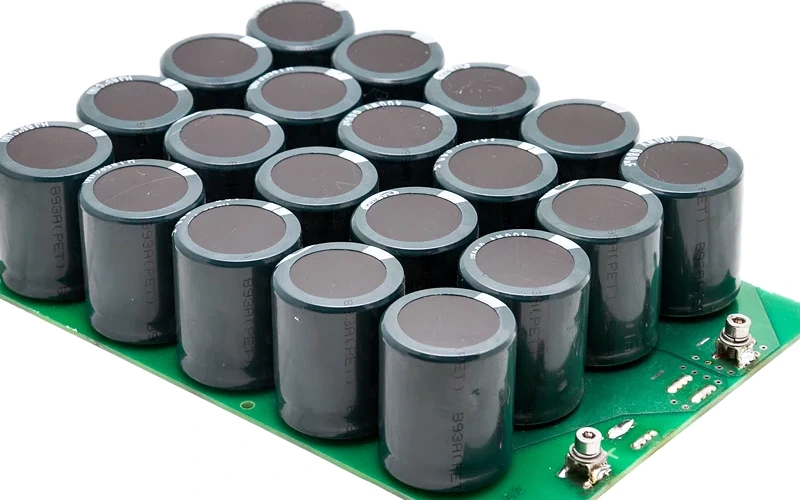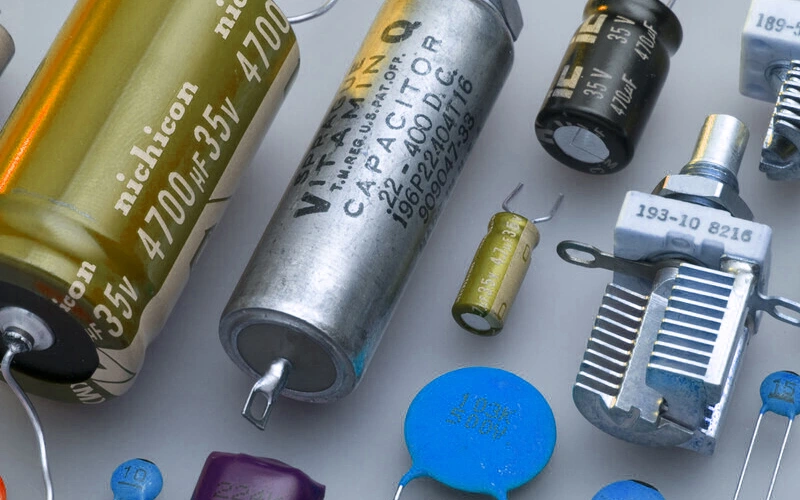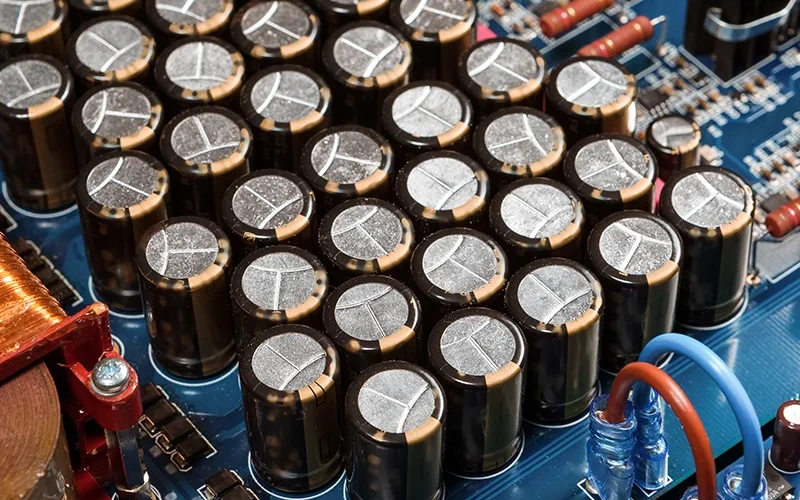
What is a Capacitor Bank?
A capacitor bank is a group of capacitors connected together to increase capacitance. It’s like a battery of capacitors, providing more energy storage and improving power factor.
A capacitor bank is a collection of capacitors designed to improve the performance of electrical power systems. Capacitors store electrical energy, and when grouped together in a bank, they help with power factor correction and reactive power compensation. Essentially, capacitor banks optimize the energy use in systems by reducing losses and stabilizing voltage levels.
Types of Capacitor Banks
Capacitor banks come in various forms to meet specific needs. These include:
- High Voltage Capacitor Banks: These are used in large-scale power systems to manage high voltage and reactive power efficiently.
- Super Capacitor Banks: Known for their high-power capabilities, these are often used in specialized applications such as electric vehicles or large backup systems.
- Variable Capacitor Banks: These are adjustable and can change their capacitance according to the power factor needs of the system.
- 3-Phase Capacitor Banks: Common in industrial applications, 3-phase systems require specialized capacitor banks to balance loads and improve the overall power factor.
- Capacitor Bank for Power Factor Correction: These are specifically designed to improve the power factor of industrial or commercial systems, which results in better efficiency and lower electricity costs.
More Types of Capacitor Banks
| Capacitor bank | Capacitor banks | High voltage capacitor bank |
| Super capacitor bank | Variable capacitor bank | AC capacitor bank |
| Auto capacitor bank | Automatic capacitor bank | Automatic power factor correction capacitor bank |
| Autovar power capacitor bank | Basic capacitor bank | Basic capacitor bank minecraft |
| 3 phase capacitor bank | 3 phase capacitor bank diagram | 3 phase capacitor bank for power factor correction |
| 3 phase capacitor bank wiring diagram | 3 phase pole mounted capacitor bank | Capacitor bank in 33 11kv substation |
| Capacitor bank in substation pdf | Capacitor bank unbalance protection | Capacitor bank types |
What Does a Capacitor Bank Do
A capacitor bank is used to store electrical energy and improve the performance of electrical systems by providing reactive power support. Its main functions are:
Power Factor Correction: In power systems, electrical loads often consume both real power (used to do work) and reactive power (needed to maintain voltage levels). A capacitor bank compensates for the reactive power, improving the power factor (the ratio of real power to apparent power). By doing so, it reduces energy losses, increases efficiency, and helps prevent overloads in the electrical system.
Voltage Stabilization: Capacitor banks help maintain a stable voltage level in the system by supplying or absorbing reactive power as needed. This is especially important in areas where the voltage fluctuates due to varying demand.
Reducing Losses: By correcting the power factor, capacitor banks reduce the losses in the power distribution system. This leads to more efficient use of electrical energy and reduces electricity costs for consumers, especially in industrial and commercial setups.
Reactive Power Compensation: In many industrial applications, large motors and equipment that cause a lagging power factor can be offset by installing capacitor banks, which supply the necessary reactive power to maintain system stability.
Applications and Usage of Capacitor Banks

Capacitor banks are crucial in a variety of applications:
- Capacitor Banks in Substations: Substations use capacitor banks to maintain voltage stability and improve the overall efficiency of power distribution systems. Capacitor banks in substations are essential for reactive power support and power factor correction.
- Capacitor Bank for Home or Small Businesses: Even residential systems can benefit from capacitor banks to reduce energy consumption. A capacitor bank for home can improve the energy efficiency by compensating for reactive power draw.
- Capacitor Bank for Solar Systems: Solar power systems use capacitor banks to stabilize fluctuations in power output, thus improving overall efficiency and grid synchronization.
- Capacitor Bank for Transformers and Generators: Capacitor banks are used to provide reactive power to transformers and generators, ensuring these systems operate smoothly under various load conditions.
| Capacitor bank in substation | Capacitor bank for home | Capacitor bank for house |
| Capacitor bank for generator | Capacitor bank for solar system | Capacitor bank for transformer |
| Capacitor bank distribution system | Capacitor bank for power factor correction | Capacitor bank usage |
| Capacitor bank protection |
Sizing and Calculating Capacitor Banks
Correctly sizing a capacitor bank is essential for its efficiency and performance. The process involves calculating the amount of reactive power (measured in kVAR) required by the system. Tools like a capacitor bank calculation excel sheet or capacitor bank sizing calculation help determine the correct bank size.
- Capacitor Bank Calculation Formula: The most basic formula for sizing a capacitor bank is based on the power factor correction needed and the total reactive power load.
Capacitor Bank Maintenance and Protection
Regular capacitor bank maintenance is essential for ensuring that the system operates smoothly and prevents failures. Maintenance involves checking components like capacitors, fuses, and wiring. The system can be protected using relays to prevent damage from issues like overcurrent, unbalanced power, or surge currents. Capacitor bank protection mechanisms such as overcurrent protection and unbalance protection are critical to ensure safety and optimal performance.
Capacitor Bank Ratings and Pricing
Capacitor banks are rated based on their capacity to handle reactive power (measured in kVAR). Common ratings include:
- 100 kvar capacitor bank for medium-sized applications.
- 250 kvar capacitor bank for large systems.
- 500 kvar capacitor bank for industrial power systems.
| Capacitor bank rating | Capacitor bank size | Capacitor bank sizing |
| Capacitor bank sizing calculation | Capacitor bank kvar calculation | Capacitor bank kvar formula |
| Capacitor bank components | Capacitor bank specification | 100 kvar capacitor bank |
| 100 kvar capacitor bank price | 100kvar capacitor bank | 150 kvar capacitor bank |
| 200 kvar capacitor bank | 250 kvar capacitor bank | 250 kvar capacitor bank price |
| 300 kvar capacitor bank | 300 kvar capacitor bank price | 400 kvar capacitor bank |
| 500 kvar capacitor bank | 500 kvar capacitor bank price | 600 kvar capacitor bank |
| 75 kvar capacitor bank | 33 kv capacitor bank | 33kv capacitor bank in substation |
When purchasing a capacitor bank, it’s important to consider both the capacitance rating and the capacitor bank price. Higher-capacity units typically come at a higher cost, but they provide substantial savings by improving energy efficiency.
Capacitor Bank Installation and Wiring

Installing a capacitor bank requires careful planning. The capacitor bank installation diagram provides a clear picture of how to wire the components, ensuring they are connected safely and correctly. Installation may occur in various locations like substations or industrial plants. You’ll need to follow a specific capacitor bank wiring diagram to avoid mistakes.
Capacitor Bank Failures and Troubleshooting
Capacitor banks can fail due to a variety of reasons, such as poor maintenance, over-voltage, or electrical surges. If a capacitor bank failure occurs, it’s important to conduct a failure analysis to understand the root cause. Some common issues include capacitor bank explosion due to excessive power or capacitor bank discharge when it fails to release stored energy properly.
Capacitor Bank Pricing
When considering capacitor bank pricing, you’ll need to account for factors such as the required capacity (measured in kvar), the specific type of capacitor bank, and its intended application. For example, a 100kvar capacitor bank price will differ from that of a larger 500 kvar capacitor bank price.
Capacitor Bank Protection and Control
Capacitor banks require protection from faults and overcurrent conditions. Using a capacitor bank controller and protection relay can prevent damage. These systems ensure that capacitor banks do not experience overcurrent protection, which could lead to equipment damage or energy inefficiency.
Capacitor Bank in Minecraft
Capacitor banks have even found their place in gaming, such as in Minecraft. In the game, players can use capacitor banks as energy storage units in modded systems. It’s a fun and interactive way to simulate energy storage and management.
Capacitor Bank Components and Parts
The main components of a capacitor bank include capacitors, fuses, wires, and controllers. Regular inspection of these parts helps prevent failures and ensures long-term performance.
- Capacitor bank fuse: Protects the capacitor from overcurrent.
- Capacitor bank pcb: A printed circuit board that manages electrical connections and ensures efficient operation.
Capacitor Bank in Specific Systems
Capacitor banks are used in various specific systems to optimize performance, such as:
- Capacitor bank for generator: Used in generators to ensure consistent voltage and power output.
- Capacitor bank for solar systems: Helps manage fluctuations in solar power generation and improves overall system efficiency.
- Capacitor bank for transformers: Provides reactive power support for transformers, improving stability and reducing energy losses.
Capacitor Bank Troubleshooting and Failure Prevention
Capacitor banks, like all electrical systems, require regular monitoring to prevent issues. Capacitor bank troubleshooting involves identifying problems such as electrical imbalance, excessive heating, or short circuits. Understanding the symptoms of capacitor bank failure can help prevent downtime and costly repairs.
Capacitor Bank Specifications and Sizing
The capacitor bank specification defines the parameters such as the voltage rating, frequency, and kVAR. It is essential to match the specifications to your system’s needs. The correct capacitor bank sizing ensures that the system provides adequate power factor correction without overloading.
FAQ
What is a Capacitor Bank?
A capacitor bank is a collection of capacitors connected in parallel to improve the power factor of an electrical system. Power factor is a measure of how efficiently electrical power is being used. A low power factor can lead to higher energy costs, increased electrical losses, and reduced system capacity. By improving the power factor, capacitor banks can help reduce energy costs, increase system efficiency, and improve overall system performance.
What are the potential risks associated with using capacitor banks?
While capacitor banks offer numerous benefits, they also pose certain risks, including: Overvoltage conditions if not properly protected.
Resonance issues if the system is not carefully designed.
Harmonic distortion if not properly filtered.
Fire hazards if not installed and maintained correctly.
To mitigate these risks, it’s essential to follow proper installation procedures, use high-quality components, and implement protective devices.
Can capacitor banks be used to correct power factor in both AC and DC systems?
Capacitor banks are primarily used to correct power factor in AC systems. In DC systems, power factor is not a concern, as there is no phase difference between voltage and current. However, capacitors can be used in DC circuits for other purposes, such as filtering and energy storage.
How do I choose the correct voltage rating for a capacitor bank?
The voltage rating of a capacitor bank should be higher than the maximum system voltage to ensure safe operation. A safety factor of 1.1 to 1.2 times the maximum system voltage is commonly used. It’s essential to consider voltage fluctuations and transients when selecting the voltage rating.
What is the difference between fixed and automatic capacitor banks?
Fixed capacitor banks: These banks have a fixed capacitance and are continuously connected to the system. They are suitable for applications with relatively constant loads.
Automatic capacitor banks: These banks have variable capacitance and are controlled by a controller to adjust the capacitance based on the system’s load and power factor. They are more efficient and flexible than fixed banks.
Conclusion
Capacitor banks play a critical role in improving the efficiency, stability, and cost-effectiveness of electrical systems. Whether used in substations, homes, or industrial applications, understanding the types, applications, sizing, and maintenance of capacitor banks is crucial for ensuring optimal performance. By following the right specifications and installation guidelines, you can maximize the benefits of capacitor banks and enhance your electrical systems’ overall efficiency.
Let me know if you need more detailed information on any of these topics. I hope this guide provides you with a deeper understanding of capacitor banks and their vital role in modern power systems.